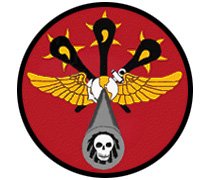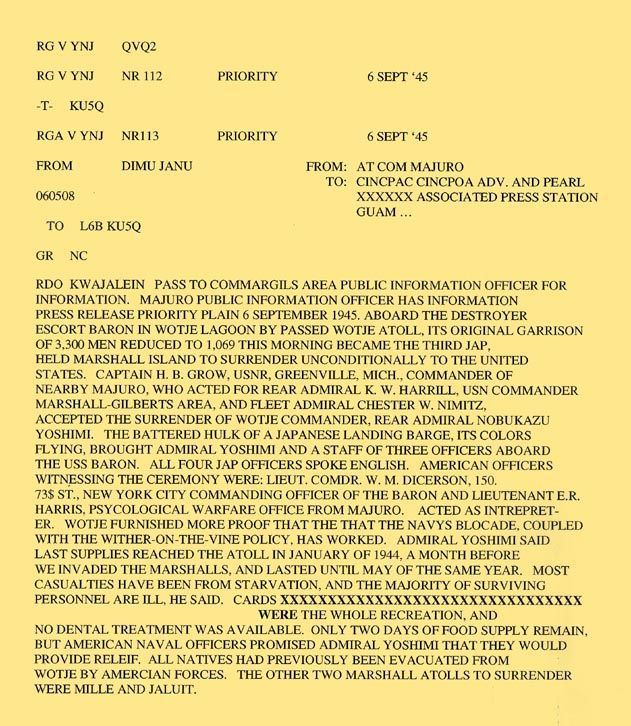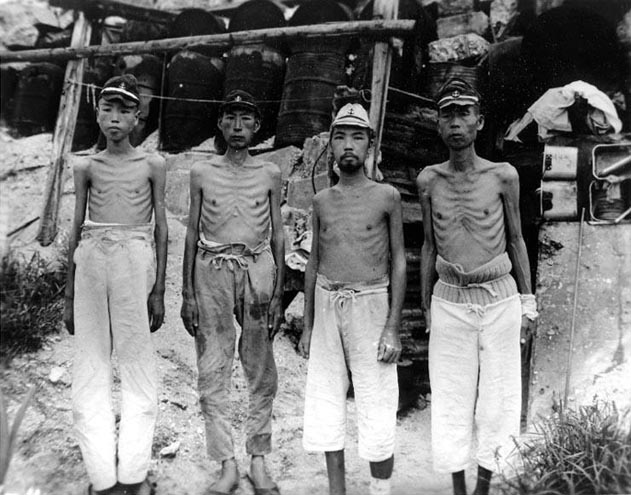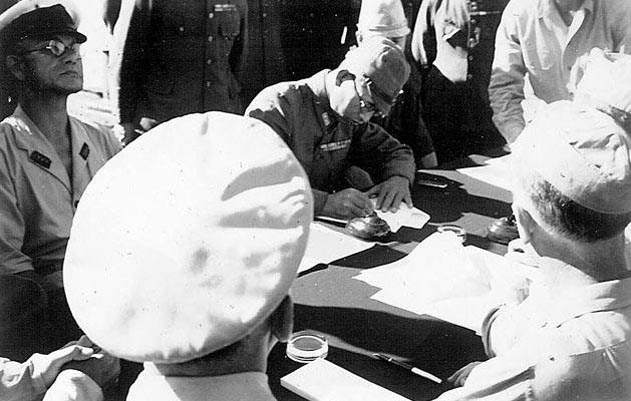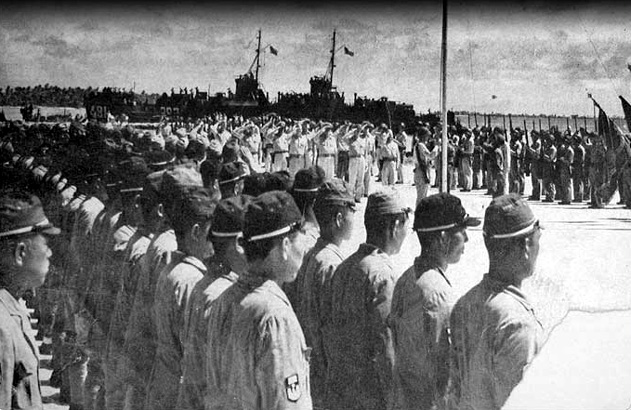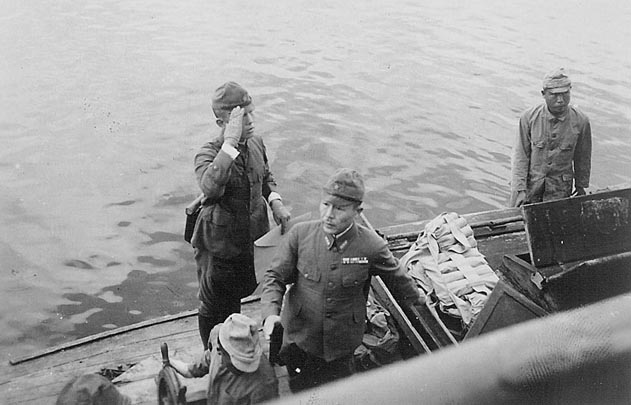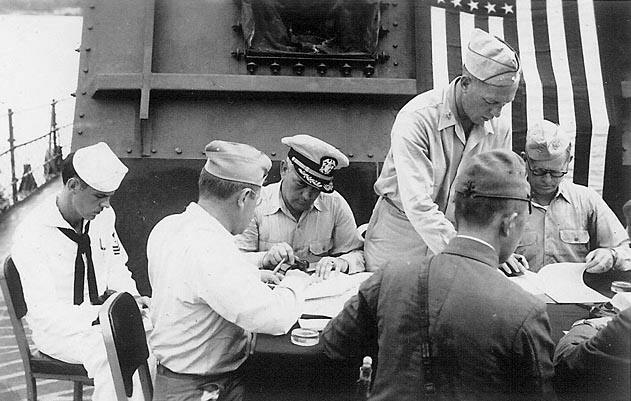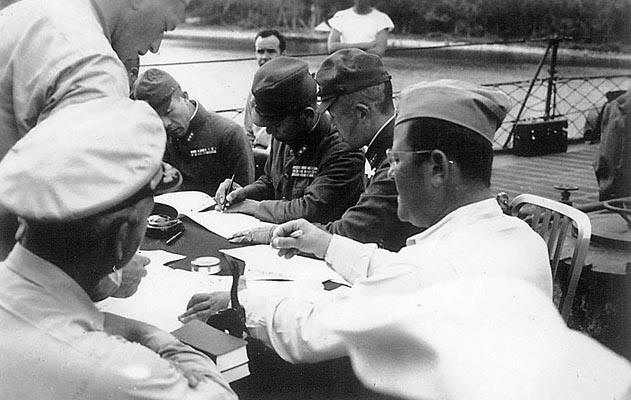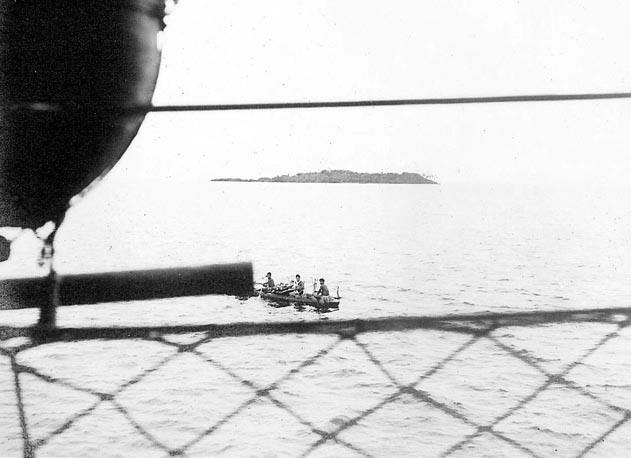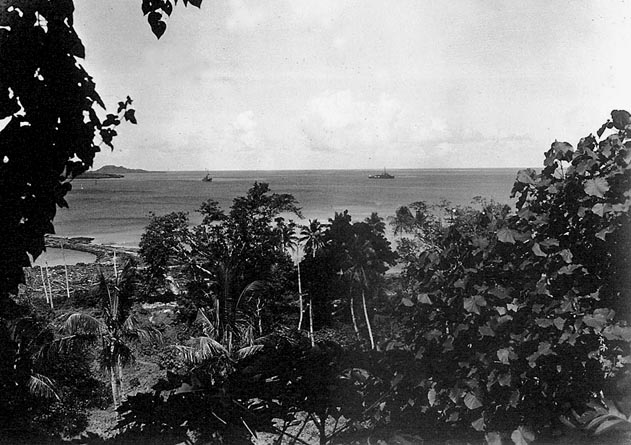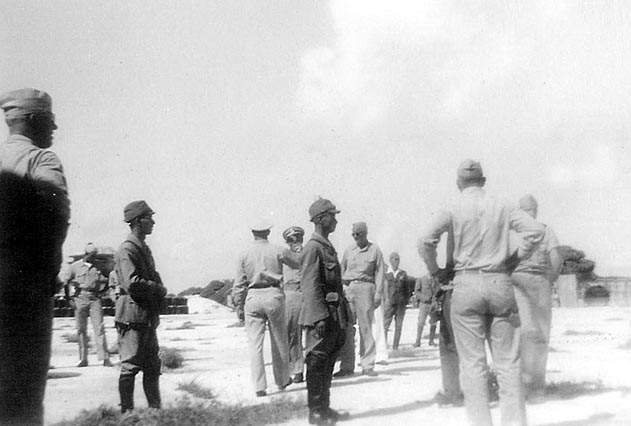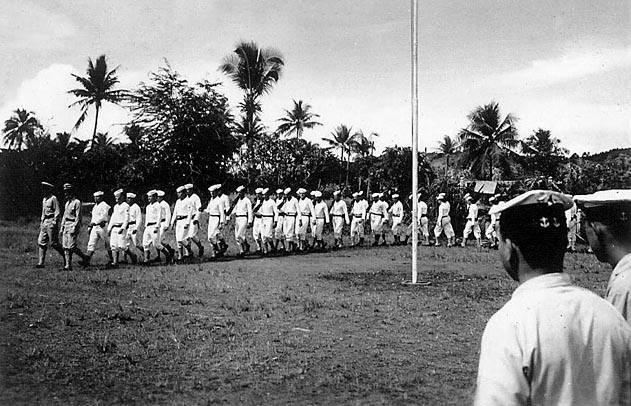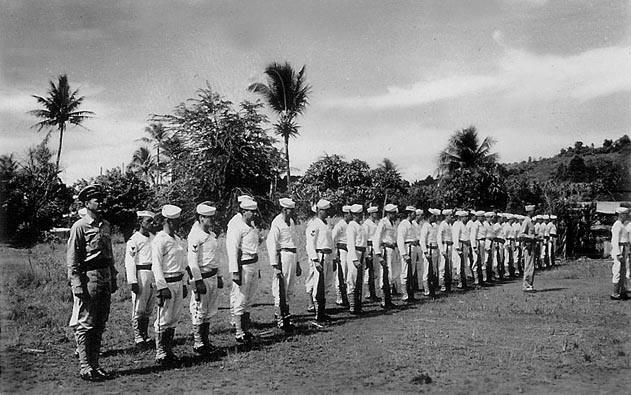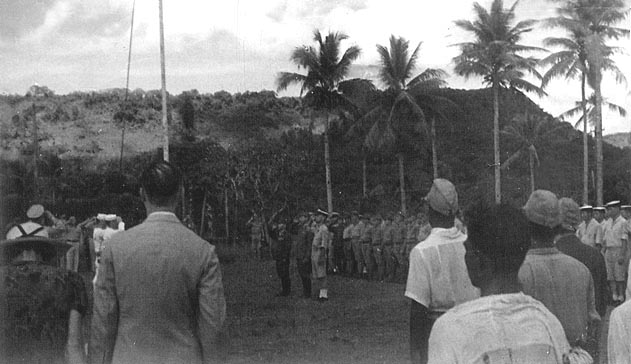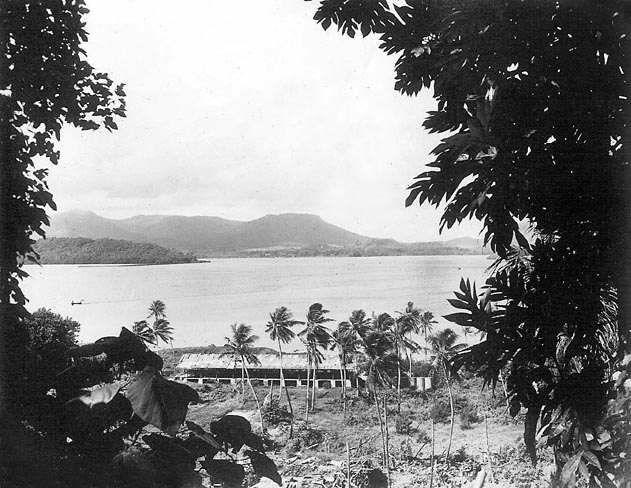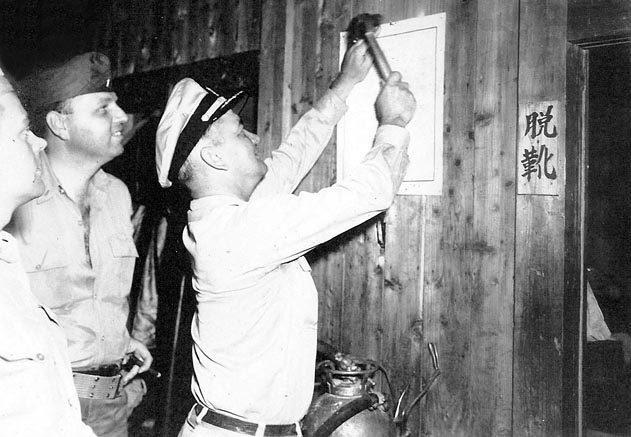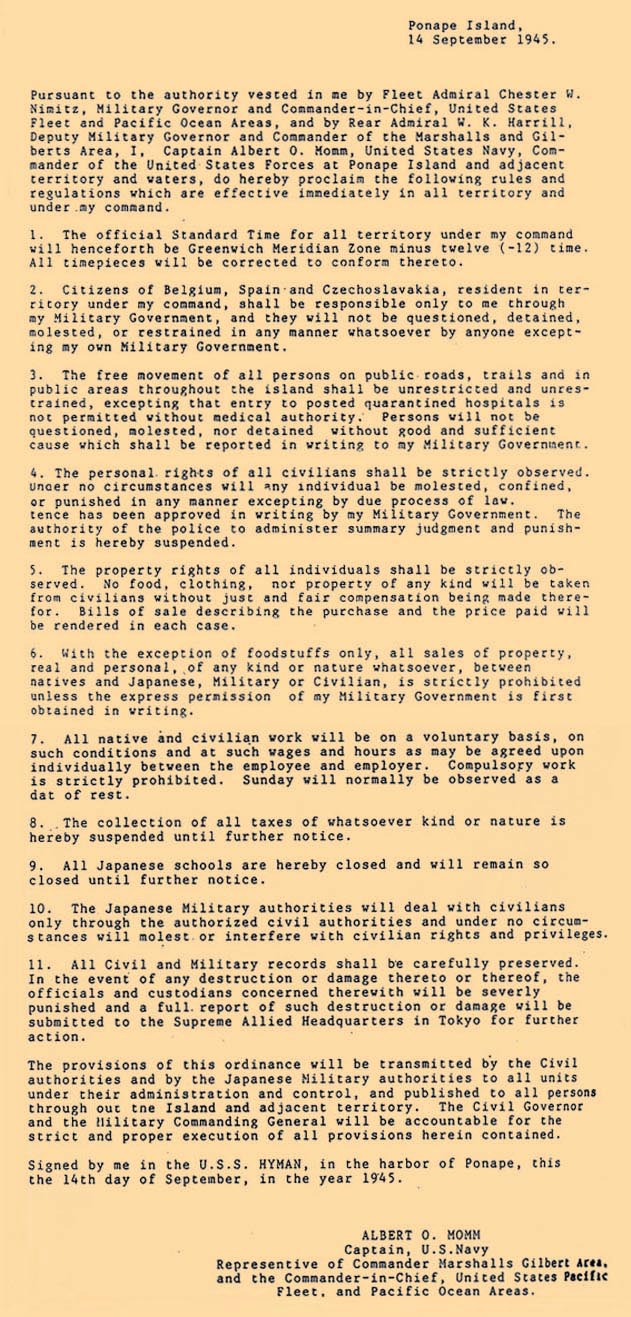|
|
||
|
|
||
|
|
SEPTEMBER 1945: PAGE 1 A daily summary of squadron activities for the month is provided below. Additional details for significant events may be found at the linked text. September 1, 1945: Two planes flew assigned shipping lane patrols. Two planes dropped surrender terms to the Japanese garrisons on Wotje and Maloelap Atolls. One plane returned to Kwajalein. One plane flew from Kwajalein to Majuro. September 2, 1945: Two planes flew assigned shipping lane patrols. One plane flew from Kwajalein to Majuro. One plane flew from Tarawa to Kwajalein. World War Two officially ends following the Japanese government's signing of the Instrument of Surrender aboard the USS Missouri (BB-63) in Tokyo Bay. September 3, 1945: Two planes patrolled assigned shipping lanes. One plane conducted a snooper flight over Kusaie. September 4, 1945: Two planes flew assigned shipping lane patrols. One plane flew a search of the southern sector. One plane performed a search of the northwest sector. One plane conducted a snooper flight over Kusaie. One plane flew from Kwajalein to Eniwetok. September 5, 1945: Nine planes conducted and air-sea rescue search. One plane performed a search of the northeast sector. Two planes operating from Majuro provided air cover for the surrender of Jaluit Atoll. One plane flew assigned shipping lane patrol. September 6, 1945: Two planes patrolled assigned shipping lanes. One plane conducted a snooper flight over Kusaie. One plane flew from Kwajalein to Tarawa. September 7, 1945: Two planes patrolled assigned shipping lanes. One plane conducted a snooper flight over Kusaie. One plane performed a patrol of the northeast sector. One plane flew a snooper flight to Ocean and Nauru Islands. September 8, 1945: Two planes flew assigned shipping lane patrols. One plane flew from Tarawa to Majuro. September 9, 1945: Two planes flew assigned shipping lane patrols. Two planes flew from Majuro to Kwajalein. September 10, 1945: Two planes flew patrols of assigned shipping lanes. One plane dispatched to destroy mine fields. One plane flew from Kwajalein to Majuro. Two planes flew cover for surrender of Wotje Atoll. September 11, 1945: Two planes flew assigned shipping lane patrols. September 12, 1945: Two planes flew assigned shipping lane patrols. One plane conducted a reconnaissance of Ujae Atoll. One plane flew a snooper flight over Kusaie. One plane returned from Kwajalein to Majuro. September 13, 1945: Two planes flew assigned shipping lane patrols. One plane flew from Majuro to Kwajalein. One plane flew from Kwajalein to Majuro. September 14, 1945: Two planes flew assigned shipping lane patrols. Two planes dispatched to destroy an incendiary cluster on near Carlos Island. One plane provided escort for fighters from Majuro to Roi. One plane conducted a reconnaissance flight over Jemo Island. September 15, 1945: Two planes flew assigned shipping lane patrols. September 16, 1945: Two planes flew patrols of assigned shipping lanes. September 17, 1945: Two planes flew assigned shipping lane patrols. One plane flew from Majuro to Kwajalein. September 18, 1945: Two planes flew patrols of assigned shipping lanes. September 19, 1945: Two planes flew assigned shipping lane patrols. One plane flew from Majuro to Kwajalein. September 20, 1945: Two planes flew assigned shipping lane patrols. September 21, 1945: Two planes flew patrols of assigned shipping lanes. One plane flew from Majuro to Kwajalein. One plane flew to Engebi Island and returned to Kwajalein. One plane conducted a reconnaissance flight over Bikar Atoll. September 22, 1945: Two planes flew assigned shipping lane patrols. September 23, 1945: Two planes flew assigned shipping lane patrols. September 24, 1945: Two planes flew patrols of assigned shipping lanes. One plane flew a search mission for a lost boat in Kwajalein Lagoon. September 25, 1945: Two planes flew assigned shipping lane patrols. One plane conducted a reconnaissance flight over Bikini Atoll. September 26, 1945: Two planes flew assigned shipping lane patrols. One plane flew from Majuro to Kwajalein and returned. One plane performed a dusk security patrol flight. September 27, 1945: Two planes flew assigned shipping lane patrols. One plane flew a dawn security patrol flight. One plane performed a dusk security patrol flight. September 28, 1945: Two planes flew assigned shipping lane patrols. One plane flew a dawn security patrol flight. One plane performed a dusk security patrol flight. September 29, 1945: Two planes flew assigned shipping lane patrols. One plane flew a dawn security patrol flight. One plane performed a dusk security patrol flight. September 30, 1945: Two planes flew assigned shipping lane patrols. One plane flew a dawn security patrol flight. One plane performed a dusk security patrol flight.
WOTJE SURRENDERS: This message, dated September 6, 1945, announced that Japanese forces on Wotje Atoll had surrendered. Wotje Island commander, Rear Admiral Nobukazu Yoshimi surrendered the surviving garrison of 1,069 aboard the USS Baron (DE-166). Photograph: U.S. Navy Historical Archives
STARVED JAPANESE: Taken on Wotje or Maloelap, this photograph bears mute testimony as to effectiveness of the air campaign against the bypassed Japanese bases in the Marshall Islands. Constant air patrols prevented any Japanese ships or submarines from providing food or supplies, leaving those on the islands to fend for themselves. More Japanese died of starvation on these islands than as a result of the frequent bombing and strafing attacks. Photograph: U.S. Navy Historical Archives
ANOTHER ISLAND CAPITULATES: A Japanese officer signs the Instrument of Surrender for his island garrison. The island in question is unknown at this time, but it is most likely Jaluit, Maleolap, or Wotje. Photograph: U.S. Marine Corps, Arthur H. Navarre Collection (Courtesy of Diane Hindy)
MORE SURRENDER NEGOTIATIONS: An unidentified Japanese officer listens intently as the terms of surrender are stated. Once again, the actual island in question is unknown, but it is most likely Jaluit, Maleolap, or Wotje. Photograph: U.S. Marine Corps, Arthur H. Navarre Collection (Courtesy of Diane Hindy)
JALUIT SURRENDER: On September 5, 1945 Japanese naval forces under the command of Rear Admiral Nisuke Masuda stand at attention as the Stars and Stripes is raised over the atoll. While this ceremony was taking place, a pair of VMB-613 PBJs provided air cover. A few months later Admiral Masuda was charged with war crimes for ordering the execution in 1944 of three captured American aviators. Ultimately, Masuda escaped justice by committing suicide before being brought to trial although he left a letter in which he assumed full responsibility for the executions. Photograph: U.S. Marine Corps
PONAPE SURRENDER DELEGATION: Lieutenant General Masao Watanabe of the Imperial Japanese Army and his aide arrive aboard the USS Hyman (DD-732) to negotiate the surrender of Ponape Island on September 11, 1945. Photograph: U.S. Marine Corps (Courtesy of Frank E. Acker)
NEGOTIATIONS UNDERWAY: U.S. Naval officers and Lieutenant General Masao Watanabe completing the details of the surrender of the Japanese garrison on Ponape aboard the USS Hyman (DD-732). The Instrument of Surrender was signed on September 11, 1945 with the occupation to begin the following day. Photograph: U.S. Marine Corps (Courtesy of Frank E. Acker)
PONAPE SURRENDERS: Lieutenant General Masao Watanabe signs the Instrument of Surrender of Japanese forces on Ponape. Photograph: U.S. Marine Corps, Arthur H. Navarre Collection (Courtesy of Diane Hindy)
NATIVE DELEGATION: A native canoe from Ponape approaches the USS Hyman following the surrender of the Japanese garrison. Photograph: U.S. Marine Corps, Arthur H. Navarre Collection (Courtesy of Diane Hindy)
DESTROYERS IN THE HARBOR: The USS Hyman and USS Farquhar anchored offshore of Kolonia. Both of these destroyers provided personnel for the landing party that went ashore following Ponape's surrender. Photograph: U.S. Marine Corps, Arthur H. Navarre Collection (Courtesy of Diane Hindy)
AMERICANS LAND ON PONAPE: On September 12, 1945 American naval forces landed on Ponape to begin the occupation of the island. They were greeted by various members of the Japanese garrison. Photograph: U.S. Marine Corps (Courtesy of Frank E. Acker)
OCCUPATION OF PONAPE BEGINS: Following the surrender of Ponape, Captain Momm, division commander on the USS Hyman (DD732), prepares to assume his duties as the military governor of Ponape while several officers of the Japanese garrison stand by ready to assist. Photograph: U.S. Marine Corps (Courtesy of Frank E. Acker)
NAVAL LANDING PARTY: A naval landing party from the USS Hyman and USS Farquhar marches into place in preparation to render honors as the Stars and Stripes is raised. Photograph: U.S. Marine Corps, Arthur H. Navarre Collection (Courtesy of Diane Hindy)
RENDERING HONORS: In place, the naval landing party prepares to render honors as the American flag is raised over Ponape on September 12, 1945. Photograph: U.S. Marine Corps, Arthur H. Navarre Collection (Courtesy of Diane Hindy)
"TO THE COLORS" ON PONAPE: American and Japanese forces stand together at attention as the "Stars and Stripes" are raised over Ponape on September 12, 1945. The man and woman in the left foreground are Mr. and Mrs. Carlos Escheidts, Belgian nationals who were interred during the Japanese occupation. Photograph: U.S. Marine Corps (Courtesy of Frank E. Acker)
PEACE RETURNS TO PONAPE: Following the Japanese surrender, peace once again returns to Ponape. This photograph illustrates the lush beauty of this Pacific island paradise. Photograph: U.S. Marine Corps, Arthur H. Navarre Collection (Courtesy of Diane Hindy)
UNDER NEW MANAGEMENT: Captain James M. Foley, USN, posts the Articles of Occupation on Ponape following its surrender on September 14, 1945. Photograph: U.S. Marine Corps, Arthur H. Navarre Collection (Courtesy of Diane Hindy)
ARTICLES OF OCCUPATION: Published by Captain Albert O. Momm, USN, these articles served to free the native population and the foreign nationals on Ponape from the harsh Japanese rule. Photograph: U.S. Navy Historical Archives |
|
|
Copyright © 2008 Marine Bombing Squadron Six-Thirteen Association. All Rights Reserved. |
||
